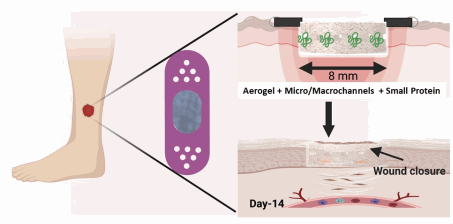Nov 23 2022Reviewed by Aimee Molineux
The University of Nebraska Medical Center and the Terasaki Institute for Biomedical Innovation have collaborated to create a fibrous aerogel that promotes quicker and more efficient healing of diabetic wounds.
 Image Credit: Terasaki Institute for Biomedical Innovation
Image Credit: Terasaki Institute for Biomedical Innovation
The ability to heal chronic diabetic wounds is made possible by the micro/macro channels engineered within the aerogel, described in the journal Advanced Functional Materials.
Additionally, a novel protein incorporated into the aerogel has anti-microbial properties and encourages the formation of new blood vessels and tissue covering for the wound.
The management of diabetic foot ulcers (DFUs) is generally difficult. Each year, numerous patients with DFUs must have an amputation, which significantly negatively impacts their quality of life. The annual cost of treating non-diabetic foot ulcers in the United States is estimated to be $1.38 billion.
DFUs are linked to impaired healing and poor clinical outcomes because of underlying issues with blood circulation, nerve damage, immune function, and fibrosis. A lower chance of recovery following surgery exists for DFUs that do not heal.
During routine wound healing, specific cells and molecules must migrate to the wound site; these cells start the formation of blood vessels and tissue regeneration, both of which are necessary for quick wound repair and closure.
By allowing cells to move through the dressings to close the wound, the microarchitecture of dressings is essential for maintaining the wound’s structural integrity. The UNMC/TIBI team created nanofibrous aerogels with organized microstructures that aided in delivering oxygen and nutrients to the wound bed and cell migration.
Furthermore, preventing infection is essential for the quick recovery of DFUs. The team has added a brand-new anti-microbial peptide to the dressing to stop bacterial growth and encourage healing. Comparing this novel peptide to commercially available anti-microbial agents, it is cheaper and more effective, which is an advantage.
The team showed that their novel dressing healed DFUs in two weeks, which was noticeably quicker than other dressings using a Type 2 diabetic wound mouse model.
The combined properties of our nanofiber aerogel work synergistically to produce a superior treatment for diabetic wounds.
Ali Khademhosseini, PhD, Chief Executive Officer and Director, Terasaki Institute for Biomedical Innovation
The study’s authors include Alec McCarthy, Justin Dyke, Yu Shrike Zhang, Ali Khademhosseini, and Jingwei Xi, in addition to Johnson V. John, Navatha Shree Sharma, Guosheng Tang, Zeyu Luo, Yajuan Su, S.M. Shatil Shahriar, Guangshun Wang, and Shelbie Weihs.
The Nebraska Research Initiative grant, the University of Nebraska Medical Center (UNMC), the National Institute of General Medical Science (NIGMS) under Award Numbers R01GM138552 and R01GM13403, and NE LB606 provided financial support for this work.
Source: https://terasaki.org/institute/